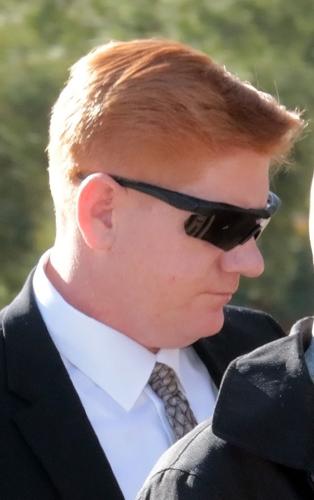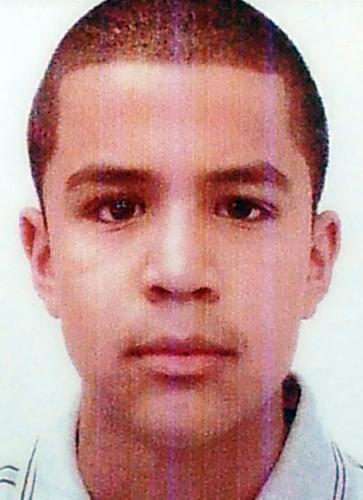Border Patrol agent Lonnie Swartz told jurors several times that he elected to protect himself and fellow law officers when he shot through the border fence in Nogales, killing 16-year-old Jose Antonio Elena Rodríguez.
In a surprise move, the 43-year-old agent testified Monday in his second-degree murder trial after prosecutors rested their case last week.
Swartz fired 16 shots through the border fence in 34 seconds, in response to a group throwing rocks from Mexico to help two alleged drug smugglers jump the fence on Oct. 10, 2012. Elena Rodríguez was struck 10 times, eight in the back and twice in the head.
During his more than two-hour testimony — including cross-examination — Swartz told the jury he heard rocks hitting the fence, and that a fellow agent said he had been hurt and another agent told a Nogales police officer that his police dog had been hit. One of the alleged drug smugglers climbing the fence had a large knife in his pocket, he said.
“I was scared, scared to be hit by a rock, (scared) for my partner,” Swartz said. “I had to act quickly. I only had seconds to stop the threat.”
The agent Swartz said had been hurt, Shandon Wynecoop, testified earlier in the trial that a rock had fallen and rolled onto his foot but that he didn’t recall saying anything about getting hit.
Nogales police Officer John Zuñiga said an agent told him his dog had been struck, but he didn’t find any injuries on the animal and didn’t believe that was the case. When asked by the prosecution whether he or his dog needed defending that night, the officer said “no.”
Surveillance videos show Swartz putting his .40 caliber pistol through the fence bollards, firing three times, then moving along the fence about 45 feet, shooting 10 more times, stepping back to reload and firing three more shots.
Although Swartz told jurors he thought he first drew his pistol after hearing the rocks and that the agent had been hurt, video shows him with his weapon out earlier than that as he approached the scene.
After the shooting, Swartz remembered he called in on the radio to say there was someone down on the Mexican side. He walked away toward a light pole where he “threw up uncontrollably,” he testified, as he started crying and softly said “sorry” as he wiped his eyes. “Why?” asked Sean Chapman, one of two attorneys representing him. “Because I had just discharged my weapon at a human being.”
Swartz told the jury he can’t remember much of what happened after he shot the second time. He said he couldn’t remember how far he moved up the fence, nor how many shots he fired and that he reloaded his weapon and fired again. He just knew he perceived a second rock thrower, he said.
“I’ve tried to remember ever since that night, I don’t know why,” Swartz told Chapman. “I’ve struggled with this for five-and-a-half years. I want to remember. It’s a piece of my life wiped away and I can’t get it back.”
During cross-examination, Assistant U.S. Attorney Wallace Kleindienst pushed back. “Don’t you think it’s a convenient way to not have to account for your actions that night?” Kleindienst asked Swartz.
Why could Swartz remember what the other agents had said, calling on the radio and what he said, but couldn’t remember where he had seen a second rock thrower or how many rounds he had fired or that he had reloaded his weapon, the prosecutor asked.
“Can you tell this jury how 10 bullets ended in the body of one rock thrower?” Kleindienst asked.
“No sir,” Swartz answered. “You can’t tell us?” the prosecutor continued. “No,” the agent said. “All I can tell you is what I perceived that night,” a phrase he continued to repeat in response to the prosecutor’s questions.
The Border Patrol doesn’t train agents to shoot at someone who is no longer a threat, Swartz said, “and I would never intentionally fire upon anyone who didn’t pose a threat.”
The defense called Dr. Laurence Miller, a psychologist who specializes in police and forensic psychology, to talk about what happens to the brain in life-or-death situations. Using a Power Point presentation, Miller talked about brain mechanisms and how they act in high-stress scenarios.
“Try to imagine a situation where you had to react very quickly and did things that later you couldn’t believe you had accomplished that enabled you to survive,” he told the jury. “Everything we do goes through multiple layers of processing before we are even aware of it. What you actually see, what you actually hear, a lot of it depends on what you are paying attention to in that particular moment,” he said.
Tunnel vision, feeling like time is moving in slow-motion and the threat is magnifying, are common responses in emergency situations, not just shootings, Miller said, but also instances where a person survives a car accident or a plane crash.
“You can perceive danger greater than it is and react accordingly. The environmental conditions under which this occurs add another layer of confusion to an already confusing and stressful situation,” he said.
It is also not uncommon that people who go through these situations don’t remember everything, he said, because the brain is busy trying to keep the person alive — “everything else will be pushed aside.”
Assistant U.S. Attorney Mary Sue Feldmeier asked Miller if he knew that the distance between Swartz and the rock throwers was 70 to 90 feet and that they were below a 22-foot fence and a 14-foot cliff. “No,” Miller responded. She asked why Swartz remembered some things when the threat was the greatest but not something that happened seconds later.
Miller answered that you would have to go inside the agent’s mind to determine when he perceived the greatest threat. What Swartz described to him during their Skype meetings was consistent with the more than 100 interviews he’s done with officers involved in shootings that have been deemed justified, he testified.
From the beginning of the trial, Chapman has said that what happened that night has to be seen from Swartz’s perspective and what he perceived to be happening at that moment. The use of force is based on each agent’s assessment of the situation, he has said, and can’t be judged in hindsight from the comfort and security of a courtroom.
While most of the agents and officers who were at the scene that night testified to seeking cover and not drawing their pistols, the defense has insisted the use-of-force policy doesn’t explicitly tell agents they must seek cover at all times when being attacked by rocks. Instead, agents need to assess the situation and decide what to do.
But the use-of-force policy also tells agents they can only use deadly force when it is reasonable and necessary, prosecutors have said, meaning it should be a last resort. If they have other options, such as backing away or seeking cover, they should. That night, they’ve said, Swartz had other options.
Earlier in the trial, the government went over six previous instances in which Swartz had filed reports after using less-lethal force in response to rocks. For prosecutors, it showed a pattern of an agent using some type of force when rocks were thrown at him. But for the defense, it showed an agent who, based on his previous actions, would have used a less-lethal weapon if he had one available the night of the shooting. Certification to use such weapons is voluntary and Swartz was certified to use several types.
Agents working at the ports of entry, as Swartz was, normally don’t carry a pepper ball launcher or other large non-lethal weapons that can be used against rock throwers or to disperse crowds, agents testified. Swartz arrived at the scene that night from the port of entry.
Swartz was stationed in Nogales starting in February 2011, after finishing the academy. He eventually became a firearms instructor.
Toward the end of his cross-examination, Kleindienst asked Swartz whether he had cried for himself or for the person he had killed.
“Because I discharged my weapon at a human being,” he responded. “I don’t ever feel good about that ever. That was the only thing in my belt that night to stop them rocks,” he continued, visibly emotional. “I don’t know how many rocks … my partner’s been hit and I’m going to defend myself and I’m going to defend my partner.”
Araceli Rodríguez, Elena Rodríguez’s mother, stepped out of the courtroom as soon as the agent started to testify.
The trial will continue Tuesday in U.S. District Court in Tucson with more witness testimony from the defense.







